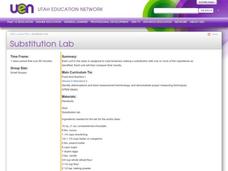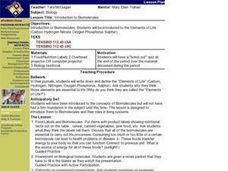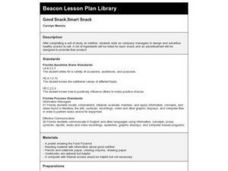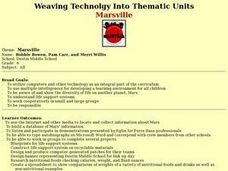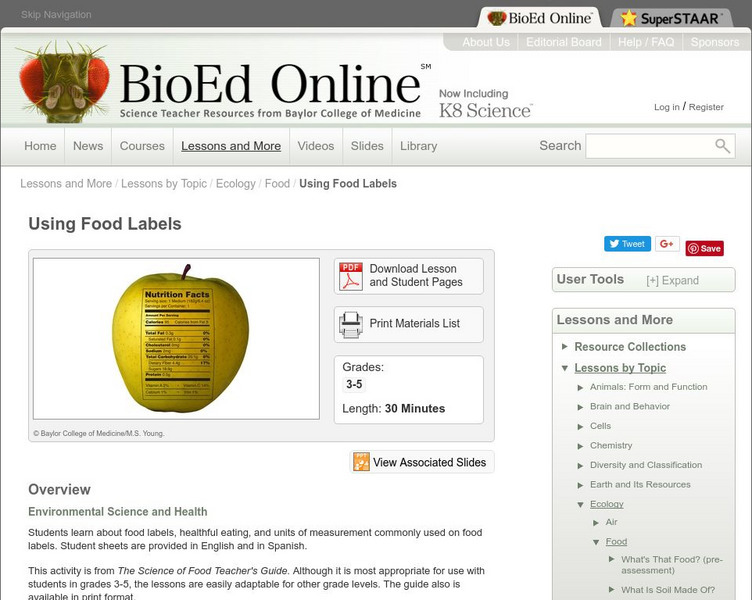Curated OER
History in the Making: The Tortilla
Fourth graders examine the history of the tortilla and extend the study across the curriculum. In this history of the tortilla lesson, 4th graders research the background of the tortilla, determine the ingredients, and work with the...
Curated OER
Modifying Viscosity of Egg Yolk
Students investigate the effects of substances on the viscosity of egg yolks. In this viscosity lesson plan, students separate egg yolks from their albumen and then add different masses of albumen back to each egg yolk. They measure the...
Curated OER
Health Lesson Plans
With childhood obesity becoming an epidemic, it's more important than ever for elementary students to learn healthy habits early on.
Curated OER
Health and Home Economics
Eighth graders conduct research on a topic of choice. They discuss the topics of copyrighting, plagiarism, and biblipgraphic format issues, conduct research using a variety of materials and resources, and create a poster, travel...
Curated OER
Thanksgiving Friends
Students listen to teacher read alouds of books that include facts about Thanksgiving. They discuss what they are thankful for and share this discussion with another class through e-mail.
Curated OER
Substitution Lab
Students in cooking class prepare and cook brownies, making a substitution with one or more of the ingredients as instructed. They compare their results in regard to appearance, flavor and texture. They develop an understanding of...
Curated OER
Fighting Hunger
Eighth graders investigate domestic hunger. In this Current Events lesson, 8th graders read and discuss "The Fighting Mynahs". Students conduct online research for a specific topic.
Curated OER
Claire Damarodas
Fifth graders examine how sugars may be listed as an ingredient in various ways. E.g. Many of the words end in -ose (ex. Sucrose, dextrose, maltose)
Curated OER
Calories, Energy for Exercise and Life
Students calculate the number of calories they need daily and examine the impact of exercise on their caloric needs. They then determine if their daily caloric intake meets or exceeds their daily need.
Curated OER
Introduction to Biomolecules
Young scholars are introduced to biomolecules and their roles in livin systems. They are introduced to the "Elements of Life." Students write down and define the "Elements of Life." They are asked why they think those elements are...
Curated OER
Sentence Fragments Worksheet 1
In this grammar worksheet, students identify which sentences are fragments and then rewrite each fragment they find into a complete sentence below the fragment.
Curated OER
Rice Plants
Second graders investigate what plant is closely related to to rice. In this rice farming lesson, 2nd graders dicover the parts of rice and that rice is closely related to grass. Students create a rice picture and write sentences...
Curated OER
Chemical Leavening Agents
Young scholars examine chemical leavening agents in dough and batters.
Curated OER
Journal Prompts for November
In this journal prompts for November worksheet, students cut the cards (there are three on a page) then use one for each day in November as a prompt for journal writing.
Curated OER
Good Snack,Smart Snack
Second graders pretend to be company managers who design and advertise healthy snacks to sell.
Curated OER
Marsville
Sixth graders use the Internet and other media to locate and collect information about Mars and build a database of information. They listen and participate in demonstrations presented by Eglin Air Force Base professionals. They then are...
Curated OER
Nine Examples for Tables, Pictographs, Mean. Median, and Mode
In this graphical representation of data and measures of central tendency worksheet, students calculate mean, median, and mode and answer questions related to graphs, tables, and pictographs.
Curated OER
Touch the Past: Archaeology of the Upper Mississippi River Region
Students examine the archeology of the Mississippi River Valley. Using the internet, they expand their research to include how the Native Americans in California used plants to meet their needs. They also research a Native American...
BioEd Online
Bio Ed Online: Using Food Labels
Do you know how to read a food label? Food labels provide important information about the nutritional value of foods. In this lesson plan students will learn about food labels, healthful eating, nutrition facts, and units of measurement...
Indiana University
Area 10 Math and Technology Project: Nutrition Labels
Lesson Plan involving all aspects of reading a nutrition label. Emphasizes math skills. Includes links to a teacher outline, student copies and reference materials.
BioEd Online
Bio Ed Online: Digestion
Digestion is the process of breaking down food into smaller units. This is done by special chemicals in the body. Proteins are important for muscles and cell growth and repair. Students learn about digestion and proteins by observing the...
US Department of Agriculture
United States Department of Agriculture: Usda for Kids
The United States Department of Agriculture home page for kids. Links to many activities and learning sites.
PBS
Pbs Learning Media: Primary Source Set: Feed the Hungry With Food Stamp Programs
This collection uses primary sources to the history of food stamp programs.
Science Education Resource Center at Carleton College
Serc: Investigating Starch in Foods
This lesson would be used during our nutrition unit when discussing carbohydrates. In this classroom activity students investigate which foods have starch in them by using iodine, as well as investigate the result of iodine and lemon...







